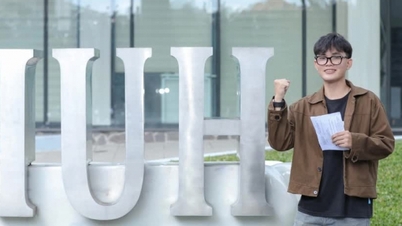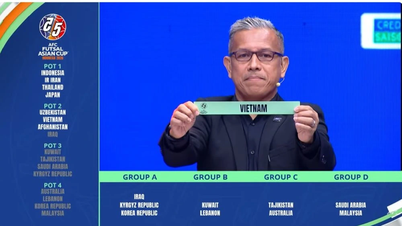According to Mr. Tran Manh Tung, in the 2025 High School Graduation Exam, Mathematics is still a compulsory subject for all candidates. There are more than 1.1 million candidates taking the exam, but the average score of this subject this year is a record low, only reaching below the average of 4.78 points. This is also the subject with the lowest average score of all the subjects and the only subject below 5.
Students have not practiced many new types of questions.
In addition, statistics from the Ministry of Education and Training show that there were up to 777 failed exams (1 point or less) in Mathematics. This is a record high number in many years.
Teacher Tung analyzed that the fact that the average score is below 5 is a strong warning sign that the majority of students do not meet the requirements of the exam and do not reach the average level.
The average score this year is also much lower than many previous years. For example, in 2021 the average Math score was 6.61; in 2022 it was 6.47; in 2023 it was 6.25; in 2024 it was 6.45.
The 2025 average score decreased so much (down nearly 2 points) that it reflects the change in the way the exam questions are set in the direction of stronger differentiation and more challenges for candidates, and the majority of students have not met the basic requirements of the exam questions, and more broadly, the requirements of the new general education program.

However, objectively, this year's Math exam is not too difficult in terms of knowledge, but strongly differentiates students, because they are not familiar with the new format of questions.
Among them, there are long, complex puzzles that take a lot of time for candidates to read and analyze, leading to not having enough time to complete the test. The main reason is that during the learning process, students have not been trained enough with new types of questions that have practical applications.
50% of candidates scored no more than 4.6 (median is 4.6)
The math score distribution shows that the average math score is 4.78 points, larger than the median (the score distribution is slightly skewed to the right), showing that most students have lower scores than the average score, while a few students have exceptionally high scores, causing the average score to increase, even though most of them did not do well on the test.
This shows a clear difference between groups of candidates. A large group had difficulty with the test while a small group did very well. From that result, the most obvious problem is to improve the general level of math ability of students in the following years, in which the teaching role of teachers at school is very important.
According to Mr. Tung, the standard deviation of Math is as high as 1.68, demonstrating a very large dispersion, indicating that the test has strong differentiation. We know that standard deviation is a statistical index measuring the dispersion of data around the average value.
In the context of test scores, if the standard deviation is small, the candidates' scores are concentrated around the average score (less differentiation). If the standard deviation is large, the scores are more widely dispersed, with candidates having very high and very low scores (strong differentiation). We can roughly divide the test scores: Standard deviation less than 1 is low, from 1 - 1.5 is average, greater than 1.5 is high.
“For Math, the average score is 4.78, standard deviation is 1.68, we understand that most students have scores from 4.78 ± 1.68 = [3.1; 6.46]. From the score spectrum, we can calculate that 785,073 candidates have scores in this section (accounting for 70%)”, Mr. Tung calculated.
Compared to other subjects, Math is the subject with the second highest standard deviation, just after Chemistry (1.81), proving that the test has really created a clear gap between students: Average students are likely to "drop out", good students have the opportunity to show off and widen the score range.
Standard deviation is not only a technical number, but also a mirror reflecting the success or limitation of the entire process of setting questions - teaching, learning - reviewing for exams.
Warning between academic records and exams , need to change teaching methods
In particular, this year, the Ministry of Education and Training announced the average grade point average of all subjects and the average exam score, in which the difference in Math is up to 2.25 points. In which, the average grade point average of all subjects in the 3 school years is 7.03, the average graduation exam score is 4.78, a difference of 2.25 points.
The first reason is that the report card score is a general assessment, while the high school graduation exam is "two in one" - it is both a graduation assessment and a basis for university admission. Furthermore, this year's exam is highly differentiated, so the exam scores are much lower.
The large difference in scores also raises a warning about the "softness" and "leniency" in internal assessment at the school. Students may have been assessed higher than their actual abilities and the average overall score increasing over the years is also an indicator of that (grade 10, average score 6.7, grade 11, average score 6.89, grade 12 jumped to 7.51).

Mr. Tran Manh Tung said that after the end of the exam, from the analysis and evaluation of the score distribution, the correlation between the average score and the exam score, it shows that the thing that needs to be done soon is to standardize testing and assessment in schools. Schools need to increase the use of common questions, standard matrices, and many levels of thinking, especially in the second semester of grade 12. In addition, educational management agencies also need to strengthen management, supervision, and inspection to minimize the situation of "loosening" scores, students can have illusions about their abilities and when taking the exam, their scores are lower than expected.
The teacher also warned about teaching and learning methods, that is, although high school has implemented the new general education program for 3 years, it seems that in many places, teachers still teach in the old way, students can only do familiar exercises, not trained in self-study, self-handling situations and real mathematical logic. Low scores on this year's exam show that students do not know how to apply the knowledge they have learned to solve problems. When faced with graduation exams with strange formats, practical questions, and differentiation, students are likely to "fall out".
The solution in the coming time is that teachers and schools need to shift from teaching and learning in the way of “math practice” to developing mathematical thinking ability. Students will grasp the nature, read well, know how to analyze, think to solve problems, and know how to apply.
In addition, over the years, the ineffectiveness of the “two-in-one” exam has been clearly demonstrated. At this point, it is necessary to evaluate and separate the two tasks: graduation and university. It is time to change the direction of assigning the graduation exam or consideration to the provinces, and university admission to the universities.
“The 2.25-point gap between the transcript and the exam scores is a wake-up call about the imbalance between real teaching, real learning, and real testing. When school scores keep "increasing steadily" while exam scores keep decreasing, what needs to be adjusted is not the exam questions - but the quality of teaching, learning, and assessment in high schools,” Mr. Tung emphasized.

Ministry of Education and Training removes 8-point math floor for semiconductor industry

Score discrepancy: Are transcripts being embellished, or are the exams too strict?

Aiming to bring Vietnamese Mathematics into the world's leading group
Source: https://tienphong.vn/khi-de-thi-doi-hoi-tu-duy-khong-the-day-va-hoc-theo-loi-cu-post1764047.tpo





![[Photo] Opening of the 14th Conference of the 13th Party Central Committee](https://vphoto.vietnam.vn/thumb/1200x675/vietnam/resource/IMAGE/2025/11/05/1762310995216_a5-bnd-5742-5255-jpg.webp)
































![[Photo] Panorama of the Patriotic Emulation Congress of Nhan Dan Newspaper for the period 2025-2030](https://vphoto.vietnam.vn/thumb/1200x675/vietnam/resource/IMAGE/2025/11/04/1762252775462_ndo_br_dhthiduayeuncbaond-6125-jpg.webp)












































































Comment (0)